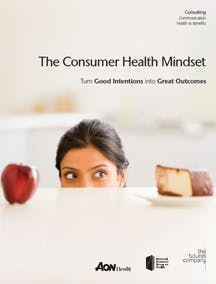We have such good intentions, particularly at this time of year.
We intend to eat better, get more sleep, head to the gym more often, budget better. Then life happens and our good intentions get sidetracked, put off, discarded.
That sweet spot between intentions and outcomes is the focus of Aon Hewitt’s 2013 Consumer Health Mindset Study, conducted in partnership with the National Business Group on Health (NBGH) and the Futures Company. This study explores the perspectives, attitudes and behaviors employees and their families hold toward health and health care, and the employee plans and offerings that support them.
Less value placed on certain actions
“We have done the survey with the NBGH for three years now, and last year the Futures Company joined us,” explained Joann Hall Swenson, one of the study’s authors and a communication consultant with Aon Hewitt. “What surprised me most are that consumers in this study still prefer email, and how much they underestimate what employers are paying toward their health care. And what’s remarkable to me (and disappointing as a communication professional) is that 34 percent don’t think they receive any health and wellness information.”
That’s not quite a surprise, but fantastic to have in “black and white” is the impact of work-related stress. Consumers call out work changes, work schedule, and influence and control over one’s work as among the top five factors causing the most intense stress.
What surprised me most was that consumers place less value this year on certain actions important to good health: getting preventive care, choosing positive lifestyle behaviors such as exercising and not smoking, and having good doctors. Possessing a positive attitude and good genes, however, jumped in their estimation.
Employees don’t understand true health care costs
The study highlights other interesting points:
- Most consumers are not receiving the information they believe will help them. They specifically want more personalized information, such as personal health tips and reminders and personal cost-savings tips. They also believe they’re not getting enough. As Joann pointed out, 34 percent believe they aren’t getting any health and wellness information at all.
- Email is the preferred communication channel, with 50 percent of respondents citing it as the way that works best for them. Only 13 percent reported an interest in employers using social media to reinforce positive health behaviors, and only 36 percent of consumers who currently use apps report an interest in health and wellness apps.
- When it comes to health care, consumers do not fully understand just how much of the cost their employer covers. In fact, they lowball the cost by about 50 percent. Consumers believe that employers pay $4,648 on average for employee-only coverage, when in fact that cost is $8,318.
- Consumers enrolled in a high-deductible health plan appear satisfied with their plan, but those with a health savings account attached to it could use more help understanding how the plan works before they enroll and determining how to invest their money once they do.
- Half of the respondents feel it’s appropriate for their employer to reward their achievement of a healthy outcome. They agree they should receive a reward if they are at the specified BMI, for example. however they feel strongly that they should not be punished. Only 15 percent of consumers agree there should be consequences for missing these biometrics.
How employers can respond
This study presents a number of opportunities for employers.
In our current economic climate, employers are making short- and long-term business decisions that lead to the stress-inducing factors consumers call out as problematic. To limit or alleviate the toll of these decisions, employers must recognize that communications regarding strategic, organizational and structural changes play a major role in employees’ ability to focus on work, feel secure, feel capable of performing their job well, and so forth.
Communicating well, routinely and clearly throughout any organizational change has always been critical. For employers invested in improving consumers’ health, this data provides another reason why.
Beyond communications, the study reveals other ways employers can help to reduce stress. Employees feel unsupported in taking vacation time or creating flexible work arrangements, and there seems to be a gap between the stress-reduction programs employers offer and employees’ awareness of them.
When it comes to delivering personalized information, things get tricky — particularly for smaller employers — due to the cost and infrastructure required to deliver truly personalized communications. However, consumers themselves provide a glimpse of what could prove helpful no matter the company size: access to groups with similar conditions.
Employees prefer the “carrot” approach
Nearly half of the consumers surveyed access health information and guidance when they experience a decline in their health, which is what we’ve also seen in Pew’s data on the social life of health information. Employers can guide consumers to reviewed and recommended sources for this guidance.
What to communicate, with what frequency, and how, is a constant struggle to get right. This study suggests a number of communication holes in understanding and value perception: the employer share of health care costs, available programs, and how to use certain benefits, being just a few.
While this study doesn’t delve into frequency, it does reveal preferred channels across a large group of respondents. Every employer should understand its own population’s preferred channels and recognize that this will vary by age and other demographics too.
Conducting a survey to identify gaps in understanding will also help employers develop their communication strategy and set their communication priorities.
Carrots versus sticks can sometimes feel like two sides to the same coin. Consumers suggest that’s the case, and they prefer the carrot — at least when it comes to outcomes-based wellness programs that tie incentives to achieving certain outcomes.
The insights in this study can guide the number of employers considering and implementing outcomes-based wellness programs in the years ahead.
This was originally published on Fran Melmed’s free-range communication blog.
